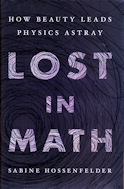Sabine Hossenfelder.
Lost in Math: how beauty leads physics astray.
Basic Books. 2018
I have been reading Sabine Hossenfelder’s Backreaction blog for a while now,
enjoying her “take no prisoners” style of explaining physics: clear and insightful on the science, blunt about the process.
One of the things she is particularly blunt about is the lack of progress in fundamental particle physics,
with its plethora of predictions over the last decades, accompanied by a paucity of experimental verification.
So I was excited to hear she was writing a book about this aspect.
And what a great book it is, both from a physics and a process perspective.
Particle physics has gone nowhere in the last 40-odd years.
The Standard Model of
the 1970s is still the best available, despite having known shortcomings.
The most recent prediction to have been experimentally verified
(the existence of the top and bottom quarks) is from 1973.
(The Higgs boson was proposed in the previous decade.)
Since the 1970s, experimental results have succeeded only in disconfirming
attempts to improve on the Standard Model.
Why this stunning lack of progress?
Hossenfelder, herself an accomplished theoretical physicist,
argues it is because physicists are beguiled by the idea of (mathematical) “beauty”,
and are being led astray in their work.
Rather than being steered by real-world data,
they are following beautiful theories, such as string theory,
down mathematical rabbit holes, further and further from experimental checks,
ending up in the bizarre place of having to redefine science itself
to allow for the absence of even the possibility of experimental validation.
The book weaves clear explanations of the problem with snippets of interviews with several of the physicists involved.
Her argument has two main components.
Firstly, theoretical beauty is not a reliable guide.
There are past examples of a beautiful theory having to give way to
a less beautiful one when confronted with disconfirming experimental data.
And many times the “beauty” of a theory becomes appreciated, or possibly learned,
only after the theory has been accepted and established.
Secondly, physics absolutely has to be grounded in experimental validation.
Mathematics is the language used to express the theories, and like any language, you can say many different things in it.
The only way to discover which, if any, of these is right, is to look to the real world.
This is a great book that will win Hossenfelder few friends in the subject.
It cuts deep to the heart of the problem,
in a very accessible manner, and exposes the groupthink lying at the heart of today’s fundamental physics.
For all my book reviews, see
my main website.

I enjoy her blog a lot. Haven't read the book, though.
ReplyDeleteIf you like her blog, you will almost certainly like her book.
Delete